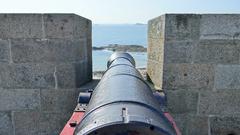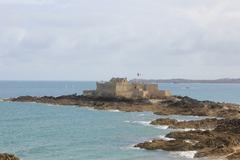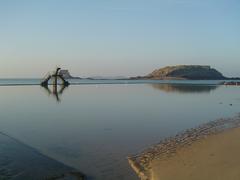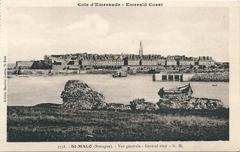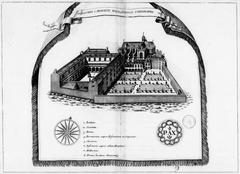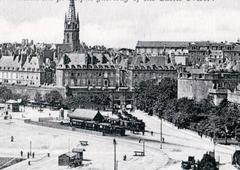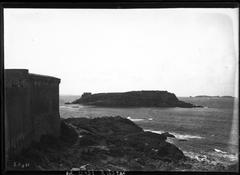Malouinière de Rivasselou: Visiting Hours, Tickets, and Complete Guide to Saint-Malo Historical Sites
Date: 14/06/2025
Introduction
Nestled in the tranquil Paramé district just outside the storied walls of Saint-Malo, the Malouinière de Rivasselou stands as a distinguished symbol of Brittany’s maritime legacy and 18th-century architectural refinement. This grand country house—known as a “malouinière”—was built by Saint-Malo’s affluent shipowners and privateers, reflecting the opulence and global connections of the city’s merchant aristocracy during its golden age. Today, Rivasselou offers a rare glimpse into the lifestyles, architectural tastes, and cultural heritage that defined Saint-Malo’s rise as a maritime powerhouse.
Whether you are a history buff, architecture enthusiast, or simply a traveler seeking to uncover the hidden gems of Brittany, this comprehensive guide covers everything you need to know about visiting the Malouinière de Rivasselou: its history, architectural features, cultural importance, practical visiting information, nearby attractions, and tips for making the most of your visit.
Table of Contents
- Introduction
- Historical Context
- Architectural Features
- Cultural Significance
- Practical Visiting Information
- Visitor Tips
- Frequently Asked Questions (FAQ)
- Conclusion and Call to Action
- References
Historical Context
Origins and Architectural Context
The Malouinière de Rivasselou is a remarkable example of the “malouinière”—a type of stately rural residence constructed by Saint-Malo’s wealthy shipowners and corsairs in the 18th century (Monumentum). These homes were built as peaceful retreats from the bustling city, yet close enough for owners to oversee their shipping and trading enterprises. Rivasselou exemplifies this tradition, featuring the symmetrical design, robust granite construction, and neoclassical elegance characteristic of the era (POP Patrimoine).
Socioeconomic Role
During the 18th century, Saint-Malo was a center of maritime trade and privateering. The malouinières served not only as homes but as powerful status symbols, embodying the prosperity brought by overseas ventures and privateering licenses granted by the French crown (Comme des Français; Saint-Malo Tourisme). The estates also reflected the city’s cosmopolitan connections, with interiors often adorned by art and artifacts from across the globe.
Conservation and Monument Historique Status
In recognition of its architectural and historical value, the Malouinière de Rivasselou has been protected as a Monument Historique since 2000, ensuring the preservation of its main house, gardens, pavilion, and enclosure walls for future generations (POP Patrimoine).
Architectural Features
Symmetry and Layout
The architecture of Rivasselou centers on strict symmetry, with a central block housing the salon and dining room, flanked by lower pavilions. The three-bay façade is punctuated by oval oeil-de-boeuf windows, robust chimneys, and finely cut granite elements. The estate is enclosed by high walls, separating the formal courtyard from the gardens and underscoring the owners’ desire for privacy (Monumentum).
Materials and Construction
Built using local Chausey granite, the mansion’s white or pale façades are designed to withstand Brittany’s maritime climate. Steeply pitched roofs and tall chimneys manage the region’s rainfall, while the granite offers durability and a distinctly coastal character (Ille-et-Vilaine Tourism).
Interior and Decorative Elements
Inside, visitors can admire original Louis XVI wood paneling, neoclassical motifs, and meticulously restored floors. While details may vary, malouinières typically feature grand staircases and period salons with exotic furnishings, fine woodwork, and imported decorative items (Saint-Malo Tourisme).
Gardens and Outbuildings
Rivasselou’s gardens, with their terraces, pavilions, and formal parterres, follow the French classical tradition. The gardens are designed for both leisure and display, and the estate’s outbuildings—such as the pavilion and walls—are protected for their architectural value (POP Patrimoine).
Cultural Significance
Malouinières are more than just architectural landmarks—they are living witnesses to Saint-Malo’s maritime golden age. Built by privateers and traders, these estates symbolize the city’s blend of adventure, entrepreneurship, and refinement. The interiors often display treasures from distant lands, and the gardens reflect Enlightenment ideals of order and beauty (Ille-et-Vilaine Tourism; Carnets Vanille).
Rivasselou and other malouinières have become central to local cultural tourism, opening occasionally for guided tours and special events like the European Heritage Days and “Rendez-vous à la Malouinière” (Saint-Malo Tourisme; Le Télégramme).
Practical Visiting Information
Visiting Hours
- Open to the public primarily during special events such as the European Heritage Days (usually in September) and the annual “Rendez-vous à la Malouinière.”
- Outside these events: Visits may be possible by appointment only.
- Check official sources (Monumentum; Saint-Malo Tourisme) for the latest schedules.
Tickets and Booking
- Ticket prices: Vary by event, typically €5–€10 for adults, with concessions for children and seniors; some heritage events offer free entry.
- Booking: Tickets often available on-site; advance booking recommended during popular events.
Accessibility and Getting There
- Accessibility: Due to historic features (stairs, uneven floors), some areas may pose challenges for visitors with reduced mobility. Contact the estate in advance to discuss needs.
- Location: In Paramé, just outside Saint-Malo; accessible by car (with parking nearby), public bus (stops: La Buzardière, Petit Paramé), cycling, or on foot via scenic routes (Ille-et-Vilaine Tourism).
- Nearby Attractions: Combine your visit with Saint-Malo’s city walls, Fort National, the Malouinière de la Ville Bague, and local markets.
Guided Tours and Special Events
- Guided tours are usually available during open days and provide detailed insights into the estate’s history and architecture. Some tours may be offered in English upon request.
- European Heritage Days and other themed events include special exhibitions and activities.
Visitor Tips
- Attire: Wear comfortable shoes for exploring gardens and navigating historic surfaces.
- Photography: Generally permitted in gardens and exterior spaces; check for restrictions inside.
- Family visits: The estate is family-friendly, though children should be supervised due to historic features.
- Check ahead: Always confirm opening times, event dates, and ticketing details before your visit.
Frequently Asked Questions (FAQ)
Q: When is the Malouinière de Rivasselou open to the public?
A: Typically during European Heritage Days and special events; other visits by appointment.
Q: How much are tickets?
A: Admission generally ranges from €5–€10 for adults; some events are free.
Q: Is the site accessible to people with disabilities?
A: Some limitations exist due to historic architecture; inquire ahead for accommodations.
Q: Are guided tours available?
A: Yes, especially during public events; English tours may be available by request.
Q: Can I combine a visit with other attractions?
A: Absolutely—Saint-Malo’s historic sites, coastal paths, and other malouinières are nearby.
Q: Is photography allowed?
A: Usually in gardens and exteriors; check with guides regarding interiors.
Conclusion and Call to Action
The Malouinière de Rivasselou offers a unique journey into the legacy of Saint-Malo’s maritime aristocracy. Its exquisite architecture, preserved interiors, and formal gardens provide a window onto the region’s vibrant past. Plan your visit around special heritage events for an immersive experience, and explore the broader network of malouinières to fully appreciate Brittany’s coastal history.
Stay updated:
- Visit official tourism and heritage websites for current hours and ticketing
- Download the Audiala app for guided audio tours and event updates
- Follow us on social media for exclusive content and travel tips
Visual and Media Suggestions
- Include high-quality images of the façade, interiors, and gardens, with optimized alt text such as “Malouinière de Rivasselou visiting hours” and “Saint-Malo historical sites.”
- Use interactive maps and, where available, virtual tours to enhance the visitor experience.
References
- Monumentum
- POP Patrimoine
- Saint-Malo Tourisme
- Comme des Français
- Ille-et-Vilaine Tourism
- Le Télégramme
- Carnets Vanille
- France Voyage
- Idées Weekend
- The Crazy Tourist
